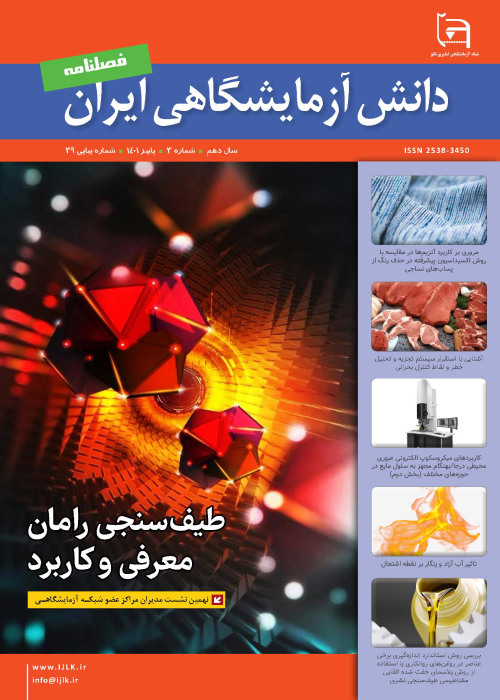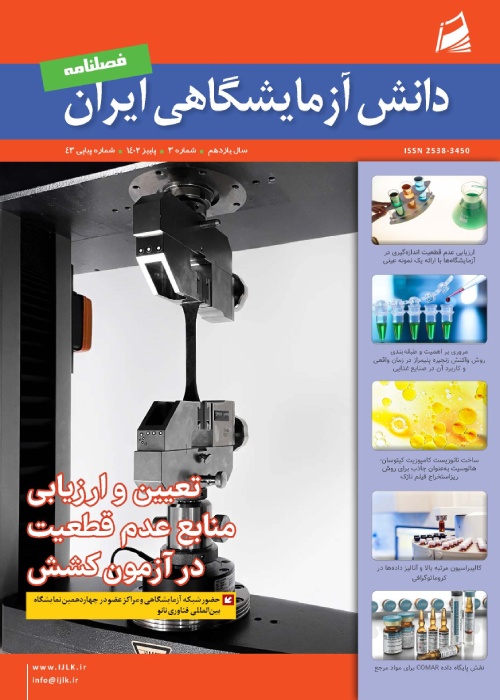فهرست مطالب

مجله دانش آزمایشگاهی ایران
سال دهم شماره 3 (پیاپی 39، پاییز 1401)
- تاریخ انتشار: 1401/09/30
- تعداد عناوین: 8
-
صفحه 2
- استاندارد
- مقالات
-
صفحه 49
-
Page 8
The Hazard Analysis and Critical Control Points (HACCP) system is designed to ensure the safety of food products. The establishment of this system in food production units identifies special risks and necessary measures to control and prevent the occurrence of risks. Also, in case of hazard, it predicts corrective measures along the food chain (from farm to table). Increasing the awareness of the interested users (quality control managers of production units, experts and students) about how to establish an efficient and continuous HACCP system is very important. The 14 stages of establishing the HACCP system include: Regulation and policy of food quality management, forming a group (team), defining the scope of application, describing the product, describing the use cases, drawing the work flow diagram, confirming the process flow diagram on site by the team and following steps (7 principles) including: conducting a hazard analysis and identify control measures, determining the Critical Control Points (CCPs), determining the critical limit or limits for each CCP, creating a monitoring system for each CCP, determining corrective measures for possible deviations, determining methods for confirming the system (verification), and finally, the establishment of the archiving and documentation system, which is given in the national standard of Iran under number 4557.
Keywords: Risk analysis system, critical control points, quality management, HACCP, Iranian nationalstandard No. 4557 -
Page 19
Reducing water resources is a global problem. Effective treatment of wastewater is an important step in maintaining water resources. Some pollutants such as pigments are resistant to conventional treatments and remain in the environment. The disposal of bio-waste is not a very practical and reliable method, as 53% of the 87 colors derived from wastewater are known as non-biotic. A chemical method for oxidizing organic matter is used by oxidizing agents such as ozone, H2O2, UV light or compounds like other oxidizing agents, which are known as advanced oxidation processes (AOPs). The use of biochemical processes in the treatment of colored wastewater has attracted a lot of interesting results. This describes the use of enzymes as an alternative and useful method for treating such contaminants. In this study, in addition to reviewing these methods, we try to compare their weaknesses and strengths
Keywords: Textile Wastes, dye, Enzymes, AdvancedOxidation -
Page 27
Since the invention of the optical microscopy, scientists knew that in order to achieve higher understanding/ insight into samples Nano-structure they had to increase the magnification. Therefore they strived to make an equipment to further enhance low magnification of the optical microscopy. After much effort, Ernst Ruska developed the first equipment that instead of light used a beam of electrons that was transmitted through the sample and formed an image on the fluorescent screen. This instrument provides users with a vast range of magnifications (from low to very high magnifications) and because it transmit an electron beam through the samples it is called “Transmission Electron Microscopy (TEM)”. With the magnification challenge almost resolved (though even now the need for higher magnification still exist), researchers turned their attention to the matter of great importance that is a requirement for imaging and viewing samples in their native state. As every user in the field of transmission electron microscopy knows, in order to put a sample inside TEM, first it should be completely dehydrated to avoid occurrence of any sort of complications with the high vacuum environment that exist inside throughout the device. Nearly all of the samples are either inside a gaseous or liquid environment or they themselves exist in gas or liquid form. In this article we focus on the liquid samples or the samples that are inside a liquid environment. If these kind of samples are dehydrated, scientists and researchers most assuredly lose a lot of valuable information about them and won’t be able to acquire an insight into their in-situ properties that occur in nanoscale. Consequently, one of the priorities of the researchers that are active in this field became developing an instrument that allows in-situ viewing and imaging of the aforementioned samples inside their native state (liquid environment). They successfully developed a device called “In-situ Environmental Transmission Electron Microscopy equipped with liquid cell’. A comprehensive introduction of this device was published as an article in Iranian Journal of Laboratory Knowledge (No. 34 - Summer 2021) and also some of the applications of this device were mentioned in the first part of this article that was published in the previous issue of the Iranian Journal of Laboratory Knowledge (No. 38 - Summer 2022). In this current article, the rest of the applications are presented to you as the second part.
Keywords: Transmission Electron Microscopy, Liquid Cell, Nanoparticle Assembly, Nanoparticle Manipulation, Electric Biasing, Electrochemical Deposition, Lithiation, Delithiation, Nanobattery, Biology -
Page 36
Diesel is used as a fuel in many of the engines in commercial and industrial scale. Distractions encountered during the auto-ignition due to presence of water and rust in the engine or in the fuel are studied by measuring Flash point. There is increase in flash points due to presence of water, which shows free water drops are not good to present in diesel. Also this study helps to judge the quality of fuel from the bottom of the tank which is mostly havnig water drops and rust (solids).
Keywords: Auto Ignition, Combustible Fuel, Flash point, Filtration -
Page 41
Inductively coupled plasma atomic emission spectrometry is a rapid method and versatile technique for determination of trace amounts of elements in broad range of sample matrix. Different kinds of aqueous and organic samples could be analyzed by ICP method. Special conditions are considered for each of these aqueous and organic samples. Specially analyzing of samples with organic matrix are easier. Determination of metal elements in oils and its products especially crude oil, fuel, unused oils and gasoline by ICP is a routine method which use organic solvents such as toluene, xylene and chlorobenzene. Althogh polymeric and biologic compounds could be solved in organic solvents and analyzed by ICP method
Keywords: Inductively coupled plasma, ICP, elemental analysis, used oil, unused oil, oil additives -
Page 49
Vibrational spectroscopy is a complete tool for identifying and determining the structure of organic compounds, including drugs, food, polymer materials, explosives, etc. When talking about vibrational spectroscopy, usually the name of infrared method comes to mind, not Raman spectroscopy. In recent decades, there has been a development in the Raman method, especially in its instrumental part. These developments have led to its unique applications in various industries. This article deals with theory, instrumentation, sampling methods and applications of Raman spectroscopy
Keywords: Raman, spectroscopy, Identification of organiccompounds, Vibrational spectroscopy


